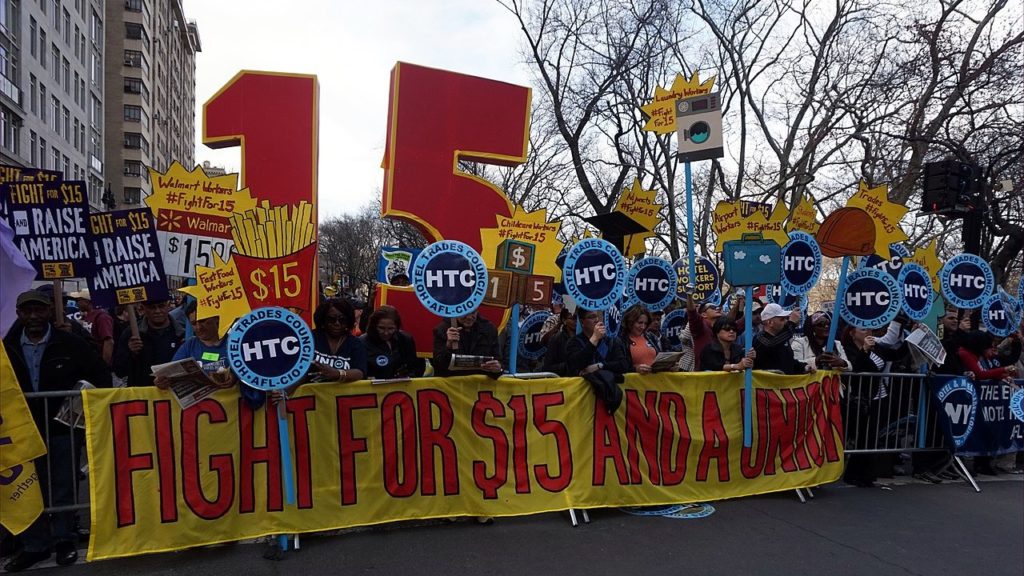The Real Minimum Wage Is Always Zero

The real minimum wage is always zero.
Restaurant workers in California are about to find that out the hard way.
Minimum wage laws are politically popular. According to the narrative, benevolent politicians race the minimum to force greedy businesses to pay their workers a decent wage. It sounds great, doesn’t it? It seems like a victory for the little guy.
The problem is you can’t suspend economic laws by government edict.
One of the biggest enduring economic myths is the notion that the minimum wage laws only help workers and have no real negative effects. The fallacy inherent in this line of thinking becomes immediately clear if we simply propose a $ 1,000-per-hour minimum wage. After all, if $20 is good, $1,000 would be fantastic, right?
Of course, nobody would pay a worker $1,000 per hour to perform a low-skill task. You’d never get any kind of return on that investment, and it’s obviously unaffordable. A $15 per hour minimum is just slightly less unaffordable. It’s only a matter of scale.
The smaller scale of a hike to $15 makes the effects much less obvious – sometimes completely invisible. But the same fundamental economic reasons a $1,000 per hour minimum wage would never work make a $15 minimum just as economically unviable.
Nevertheless, as long as we have politicians, they will pander to “workers” and pass these economically damaging laws. And as long as there are minimum wage laws on the books, some low-productivity workers will go without jobs.
A wage is nothing more than the price of labor. And labor is subject to the laws of supply and demand. When you raise the price of something, demand falls. That means raising the price to hire somebody will ultimately mean fewer people get hired.
It’s critical to understand that governments can force employers to pay you minimum wage. But they can’t force a company to hire you.
CALIFORNIA: A REAL WORLD EXAMPLE
California workers are going to learn this economic lesson the hard way.
A $20 per hour minimum wage for restaurant workers in California will go into effect in April. To cope with the increased cost of labor, two Pizza Hut operators plan to eliminate delivery service. That means some 1,200 delivery drivers will go from making their current wage to earning zero.
“PacPizza, LLC, operating as Pizza Hut, has made a business decision to eliminate first-party delivery services and, as a result, the elimination of all delivery driver positions,” the company said in a statement.
Southern California Pizza Co. also gave notice that it will discontinue delivery service.
Restaurant industry analyst Mark Kalinowski told Business Insider that he expects “more harm to come” from the law as fast food chains “take action in an attempt to blunt the impact of higher labor costs.”
Some of that pain will fall on customers. Pizza lovers will now have to pick up their orders or depend on third-party delivery services such as DoorDash and Uber Eats. Meanwhile, McDonald’s and Chipotle have already indicated that they will raise menu prices.
Gov. Gavin Newsome signed the FAST Act into law in 2022. The original plan would have raised the fast food industry minimum wage to $23 per hour. In a compromise, a law passed last year set the wage at $20. The wage applies to California-based fast-food chains with 60 or more locations nationwide.
WHAT’S WRONG WITH A MINIMUM WAGE?
Nick Giambruno did a good job of explaining the problem with minimum wages in an article published by the International Man. He points out that minimum wage laws are simply price controls.
In this case, a control on the price of labor. And price controls always create destructive distortions in the market. Here, that means unnecessary unemployment and artificially high prices passed on to consumers. Even the Congressional Budget Office admits that 500,000 jobs would be lost if the US government raised the federal minimum wage from $7.25 to $10.10.”
Giambruno illustrates this point by making a comparison that’s easy to wrap your head around. Imagine if the government set the minimum price for an aluminum can at $5. In that scenario, Coca-Cola would have to charge over $5 for a can of Coke. Would you shell out more than five bucks for a can of Coke?
Me neither.
In this scenario, we’d end up with a glut of Coke cans sitting on store shelves.
In this scenario, the problem isn’t that people don’t want Coke. They do. The problem is the artificially high price of aluminum cans… which leads to the artificially high price of Coke… that just sits on shelves, gathering dust, until eventually, Coca-Cola drastically cuts back production because of lack of demand.”
In all likelihood, Coca-Cola would just switch to exclusively using glass or plastic containers. The $5 minimum can price that was supposed to help the can companies would actually hurt them over the long term.
Now, just substitute aluminum cans for labor and you have the same scenario.
A similar dynamic plays out when the government mandates the price of labor. But instead of Coke cans, potential employees sit on the shelves while employers eliminate jobs they otherwise wouldn’t, and are forced to pass on higher prices to consumers when they otherwise wouldn’t. The plain truth is, not every job generates $15 an hour worth of output. And some workers would much rather accept jobs that pay less than $15 than have no job at all.”
Minimum wage advocates seek to solve a legitimate problem facing American workers: their dollars buy less and less every year. But simply mandating employers fork over more dollars is a little like putting a band-aid on an amputation. It doesn’t do anything to address the underlying problem. We don’t have a wage problem. We have a money problem.
Call 1-888-GOLD-160 and speak with a Precious Metals Specialist today!
Buka akaun dagangan patuh syariah anda di Weltrade.
Source link







